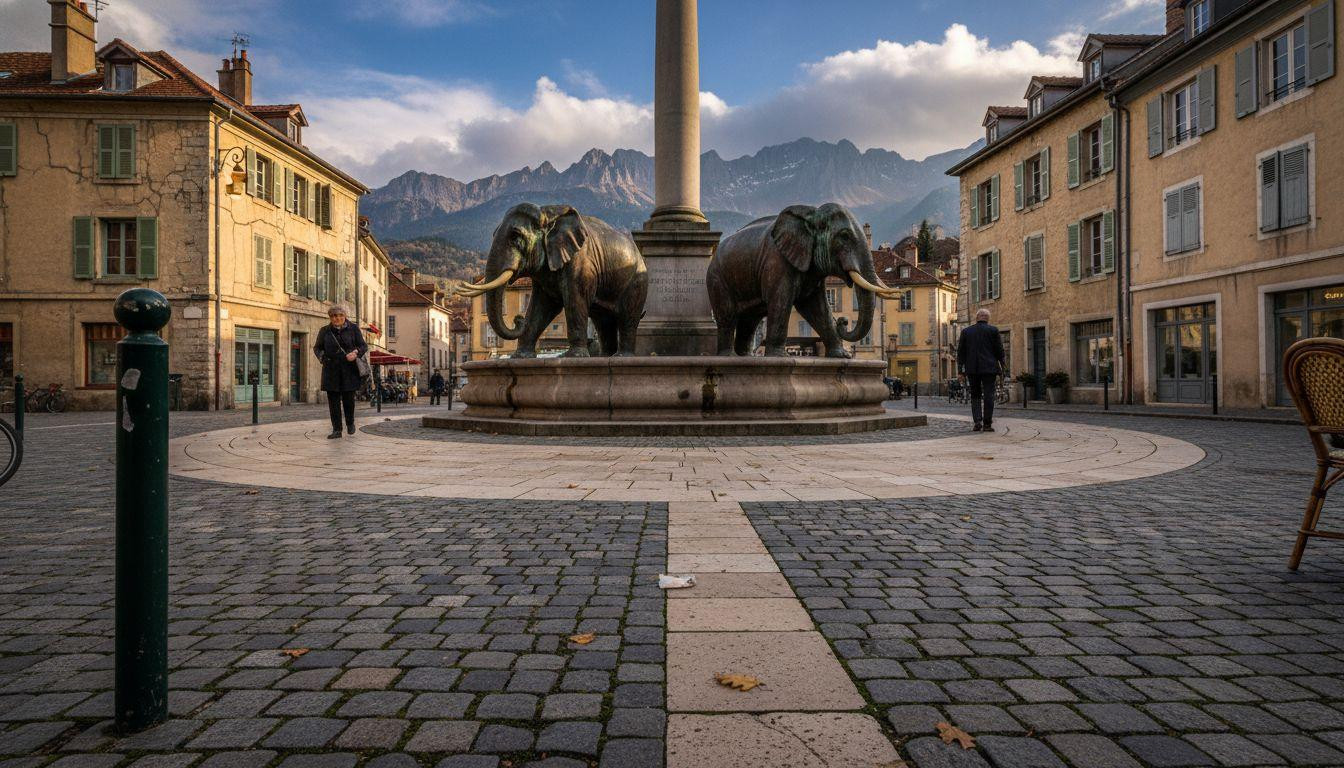Morning light touches golden limestone arcades as the Bauges mountains glow across Chambéry’s empty Place Saint-Léger. Steam rises from café windows unchanged since the 1850s. Ninety minutes from Lyon, this former Savoy capital of 60,000 residents welcomes 1 million annual visitors yet remains invisible to most travelers racing toward Annecy or Chamonix. This isn’t France’s commercialized Alps.
This is where three centuries of Italian-Alpine fusion created architecture, cuisine, and identity most overlooked cities lost long ago. At 886 feet above sea level, nestled between Pre-Alps ranges, Chambéry preserves what Annecy’s 15 million tourists have transformed into souvenir shops and $10 coffee.
Where three centuries of Savoy history meets Alpine geography
Chambéry rests in a valley gateway between the Bauges and Chartreuse Pre-Alps ranges. From 1232 to 1563, this compact city served as capital of the County (later Duchy) of Savoy. That status carved Italian elegance into every stone arcade and Renaissance courtyard.
The Château des Ducs de Savoie still anchors the old town. Its medieval-Renaissance walls now house regional government offices open to guided visits for $12-18. Piedmontese palazzos line cobbled streets where red Savoyard flags outnumber French tricolors.
Lyon sits 90 minutes west via TGV for $55-100. Geneva Airport connects in one hour for $25-40. Yet tourist flows bypass this authentic Alpine gem for lakeside crowds, leaving Savoy culture remarkably intact.
The architectural secret Annecy commercialized away
Piedmontese arcades and the Elephant Fountain’s bronze glow
Golden-beige limestone façades transition to terracotta at sunset. These mineral deposits come from nearby Alpine foothills. Wrought-iron balconies cascade with geraniums above arcaded walkways designed for Italian-style promenades.
The Fontaine des Éléphants anchors Boulevard de la Colonne. Four bronze elephants support a column honoring local benefactor Benoît de Boigne. The monument glows amber from 5:30-6:15 PM November through February.
The Gothic cathedral housing Europe’s largest trompe-l’œil
Cathédrale Saint-François-de-Sales preserves Gothic bones beneath Baroque flourishes. Its interior ceiling displays Europe’s largest trompe-l’œil mural. The Sainte-Chapelle within the château once housed the Turin Shroud until 1578.
No ropes separate visitors from 500-year-old choir stalls. No tickets required to wander cloisters where Savoy dukes planned Alpine expansions. This authentic access disappears in over-touristed destinations.
What 60,000 residents guard from tourist algorithms
Raclette, tartiflette, and the real Savoyard table
Marché des Halles operates Tuesday, Thursday, and Saturday mornings. Vendors arrange Beaufort cheese wheels, Apremont white wine, and cured meats beneath cast-iron pavilions unchanged since 1889. Local tourism boards confirm this market maintains authentic regional pricing.
Raclette costs $24-31 at family-run tables. Tartiflette (potato-Reblochon gratin) runs $22-28. Fondue savoyarde serves two for $28-35. Family cafés serve traditional recipes locals order weekly with no English menus or Instagram staging.
Lac du Bourget’s turquoise water 7 miles away
France’s deepest natural lake spreads turquoise against Dent du Chat peak 7 miles from Chambéry’s center. Cycling routes follow the western shore past Belle Époque villas and thermal springs.
Kayak rentals cost $17 per hour. November water temperature reaches 54°F, deterring swimmers but perfecting mountain reflections. The lake’s monastery island operates boat tours May-September for $20 round-trip.
The comparison tourist boards won’t make
Annecy draws 15 million visitors annually to lakeside canals now lined with souvenir shops charging $10 for coffee. Chambéry welcomes 1 million to unchanged bistros serving $4 espresso in 16th-century courtyards.
Both cities access identical Alpine trails and ski resorts within 45 minutes. Both preserve medieval architecture. The difference: Chambéry’s 60,000 residents outnumber daily tourists 8:1, maintaining genuine Savoyard culture. Mid-range hotels average $100-135 versus Annecy’s $165-245.
Authentic French experiences survive where commercialization hasn’t arrived. Farmers’ markets, local patois, and family-run restaurants remain untransformed.
Your questions about Chambéry answered
How do I reach Chambéry without a car?
TGV trains connect Paris-Chambéry in 3 hours 49 minutes for $55-100 advance purchase. Lyon-Part-Dieu reaches Chambéry in 1 hour 15 minutes for $28-45. Geneva Airport sits one hour north via regional train for $25-40.
Aéroport de Chambéry-Savoie operates 7 miles from center with seasonal European flights. Local buses blanket the compact city center. Walking covers old town sights within a 1.2-mile radius.
What’s the one dish I can’t miss?
Order tartiflette at traditional Savoyard restaurants. Layers of sliced potatoes, lardons, onions, white wine, and melted Reblochon cheese baked until bubbling. The dish originated in 1980s Savoy marketing but now defines regional comfort food.
Pair with Apremont white wine from local Savoie vineyards. According to regional visitor centers, this combination represents authentic mountain cuisine unchanged by tourist demands.
How does Chambéry compare to Annecy for first-time Alps visitors?
Annecy offers postcard canals, lakeside promenades, and tourist infrastructure with English everywhere and organized tours. Chambéry provides deeper historical authenticity, Italian-Alpine architectural fusion, and genuine local life at 40% lower costs.
Both access identical ski resorts and mountain trails within 45 minutes. Choose Annecy for scenic Instagram backdrops. Choose Chambéry for cultural immersion and authentic Alpine France.
At 6:15 PM, the Elephant Fountain glows bronze-gold while locals unlock château courtyard gates families have opened for generations. The Bauges peaks catch last light across rooftops unchanged since Savoy dukes planned medieval campaigns. This isn’t hidden France. It’s France that never needed to perform.
